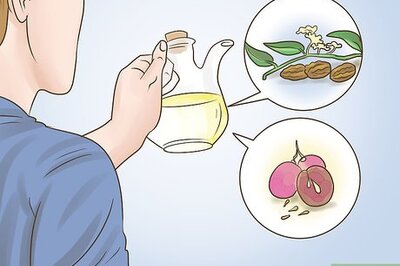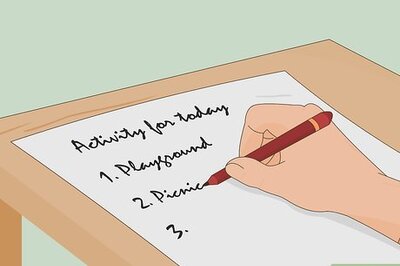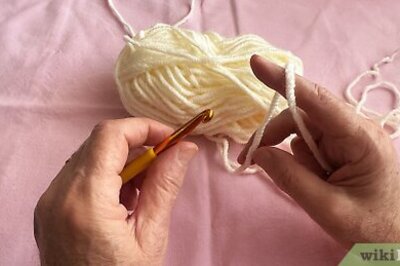
views
Accessing the Belt
Disconnect the washing machine from the power and water supply lines. Unplug your washing machine from the wall so you don’t get shocked or electrocuted while you’re working. Locate the water valves on the wall behind or next to your washing machine. Turn the valves clockwise to shut off the water supply completely so it doesn’t leak. Unscrew the lines leading from the valves to the washing machine to disconnect them. There may still be water in the lines when you unscrew them, so keep a small bucket or container nearby to catch any that falls out. Never work on your washing machine while it’s still connected to power.
Remove the access panel on the front or back of the machine. Consult with your washing machine’s user manual to find out the location of the access panel, which is usually on the front or back of the machine. Locate the screws around the access panel and use a screwdriver to remove them. After you loosen the screws, carefully lift and set the access panel cover aside so it’s out of the way. The size and location of the access panel will vary depending on your model of washing machine. If you can’t find any screws, there may be hidden latches holding the panel in place. Slide a putty knife in the cracks around the access panel to pop the latches loose.Tip: You can remove the top panel on a front-loading washing machine if you want to allow more light inside so it’s easier to see.
Look in the access panel to locate the belt. Search inside of the washing machine for a 1 in (2.5 cm) rubber belt stretched between the motor and the drum. A front-loading machine usually has the belts on the back while a top-loading machine has the belts near the bottom of the drum. If you still have trouble finding the belts, consult with the owner’s manual to locate them. Some newer washing machines don’t have belts. If you aren’t able to find any and your washing machine doesn’t work, contact a repair specialist to check it for you. Some top-loading washing machines have the belts underneath the washing machine. Lay down a towel and carefully tilt the washing machine on its side to access the belts if you need to.
Unscrew the belt cover if your washing machine has one. The belt cover is a large plastic piece that hides the drive belt and pulleys it attaches to so they don’t get damaged as easily. Locate the screws that hold the belt cover in place, and loosen them with your screwdriver. Set the screws and cover aside while you’re working so they’re out of your way. Not all washing machines have belt covers.
Pull the old belt off of the drum if it’s still attached. The drive belt connects to a large circular pulley attached to the machine’s drum and a small pulley on the motor. Try sliding the belt off of the pulley first to see if it’s loose enough to come off. If you have trouble pulling the belt off, shimmy your screwdriver underneath the belt and pry it off of the pulleys. If the belt broke or snapped, then it won’t be attached to the pulleys. Check the bottom of the machine to see if it fell or dropped.
Attaching the New Belt
Get a belt that matches the brand and model of your machine. Belt sizes and lengths vary depending on the brand and style, so it’s important to get a perfect fit. First, check the user manual for your washing machine to see if it specifies the part or size you need for your belt. If you can’t find it listed in the manual, search online for the brand and model of the washing machine so you can find the right belt that fits. You can buy replacement washing machine belts online or from specialty hardware stores. Don’t try using a belt made for another machine, or else it may not fit or work properly.
Align the belt around the drum pulley so the flat side faces out. The drum pulley is the large circular part that connects to the machine’s drum. Make sure the belt has the smooth side facing outwards and the grooved side facing inward. Loop the belt over the drum pulley so it fits into the grooves going around it. Let the belt hang loosely from the drum pulley for now. Don’t try to loop the belt around the motor pulley yet since it will most likely be too tight to position correctly.Tip: Wear long-sleeved clothing while you’re reaching inside your washing machine since there may be sharp edges that can scratch you.
Secure the belt to the drum pulley with a zip tie. Hold the belt tightly against the drum pulley so they make firm contact with each other. Feed the end of a zip tie through a hole in the drum pulley before securing the end in the clasp on the other side of the zip tie. Pull the zip tie tight so it holds the belt in place against the pulley. You don’t need to use a zip tie, but it makes it easier to stretch a tight belt that’s hard to install.
Loop the other end of the belt around the motor pulley. Locate the motor pulley, which is the small circular part connected to the machine’s motor and spins the belt. Pull the end of the belt tightly so it stretches around the motor pulley and fits into the grooves. It’s okay if the belt hangs loosely from the drum pulley for now as long as it stays in place where you put the zip tie. Consult with the owner’s manual if you have trouble determining which part is the motor pulley.
Spin the washing machine drum so the belt aligns on the pulleys. Open the door of the washing machine and reach inside to hold onto the drum. Slowly spin the drum clockwise to rotate the pulley. As the drum spins, the belt will align itself on the pulley and become tight. Keep spinning the drum until you make 1 full revolution to ensure the belt stays in place. The drum will get more difficult to turn as the belt stretches on the pulleys. You can also try spinning the drum pulley itself, but it may be more difficult.
Cut the zip tie off of the belt with a pair of scissors. Spin the drum until you position the zip tie in a place that you can easily reach. Carefully slide one of the scissor blades underneath the zip tie, and squeeze the handles together to cut through it. Pull the zip tie out from underneath the belt carefully so the belt doesn’t slip off of the pulley. Don’t leave the zip tie inside your machine since it could cause the belt to slip or cause damage. Be careful not to cut the belt, or else it could snap off more easily.
Closing the Machine
Screw the belt cover back on if you had to remove it. Position the belt cover back over the pulleys and the belt stretched between them. Feed the screws back into the holes and turn them clockwise to secure them in place. Make sure the cover doesn’t restrict or get in the way of the belt, or else the machine won’t work properly. You can skip this step if your machine doesn’t have a belt cover.
Reattach the access panel cover to seal your machine. Hold the access panel cover against your washing machine so the screw holes line up. Feed the screws back into the holes and tighten them by turning them clockwise. Start from the top of the access panel and work toward the bottom so the panel doesn’t fall out while you’re attaching it. If the access panel used latches instead of screws, line up the holes with the latches and slowly push the panel cover back in until it clicks into place.
Connect the washing machine to your water and power supplies. Make sure you line up the water valves to the supply lines you originally removed them from, or else the machine won’t work properly. Tighten the ends of the lines to the valves by turning them clockwise as far as you can. Rotate the valve handles counterclockwise to turn the water back on for your machine. Then plug the machine’s power cord back into the outlet. If you notice any leaks from the valves, turn off the water and try tightening the lines with a wrench to make them tighter.
Test using your washing machine to see if it works. Put a small load of laundry inside your washing machine and turn it onto a regular cycle. Listen for the drum spinning and motor running while you complete the load so you know the belt works properly. When you finish the load, check if the clothes are still soaking wet or if they’re mostly wrung out. If they’re still dripping wet, then the spin cycle didn’t work properly and there may still be problems. If the belt replacement didn’t work, call a specialist to look at it for you.

















Comments
0 comment